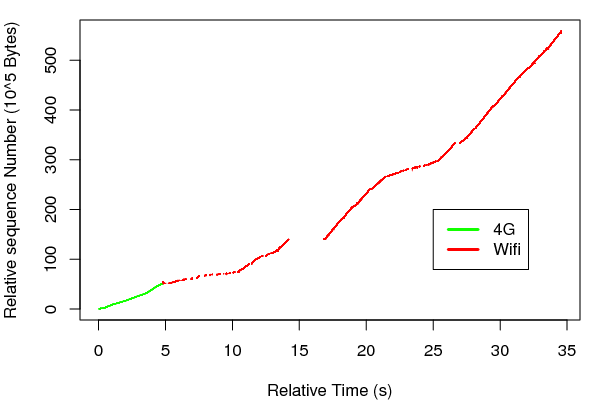MPTCP experiments on iOS 11 beta
MPTCP support has been announced for iOS 11 during wwwdc2017. The developer documentation presents a new instance property called multipathServiceType inside the URLSessionConfiguration class that can be set to one of the constants specified in MultipathServiceType enumeration, which is also in the URLSessionConfiguration class. The enumeration contains four constants and the documentation has a small description for each constant :
- none : The default service type indicating that Multipath TCP should not be used.
- handover : A Multipath TCP service that provides seamless handover between Wi-Fi and cellular in order to preserve the connection.
- interactive : A service whereby Multipath TCP attempts to use the lowest-latency interface.
- aggregate : A service that aggregates the capacities of other Multipath options in an attempt to increase throughput and minimize latency.
The code bellow shows a simple example of usage:
let config = URLSessionConfiguration.ephemeral
config.multipathServiceType = URLSessionConfiguration.MultipathServiceType.handover
let session = URLSession(configuration: config)
let url = URL(string: "http://multipath-tcp.org/data/uml/vmlinux_64")
let task = session.dataTask(with: url!, completionHandler:{...})
task.resume()
We will present experiments done with iOS in a series of posts on this blog. In our first experiment, we use the handover service type. We start the connection with the wifi interface down and after a few seconds, we turn on the wifi interface. The trace of the connection is available here. We use mptcptrace to see how the subflows are used. Let’s take a look at the Multipath-TCP sequence numbers over time :

As expected, the connection starts on the mobile interface because it is the only interface available at that time. When the wifi interface becomes available, around five seconds after the start of the connection, all the traffic is immediately sent to the wifi subflow.
Let’s take a closer look at what happens during the transition around five seconds after the start of the connection:

On this graph, MPTCP acknowledgements are pictured as blue crosses. We can see on this zoom, on the left upper corner, that the client receives out-of-sequence (from Multipath-TCP’s perspective) packets during the transition. This is due to the fact that iOS tries to terminate the connection as soon as possible on the mobile interface and the server does not know yet that it should not be used anymore. Starting from packets 4647 in the trace, we can see the zero window advertisement and resets sent by the iPhone on the mobile subflow. Once the server detects that some packets will not arrive on the mobile subflow, when it receives the reset, it reinjects the packets on the wifi subflow. During the time of the reinjections, out-of-order packets are kept in the out-of-order queue of MPTCP on the client side. To observe this out-of-sequence queue, we zoom on the right top corner of the graph :

On this graph, we can observe the MPTCP ACKs that cover the out-of-sequence packets received earlier. In particular we can observe a hole in the middle of the graph. If we zoom on other parts of the graph we can see several holes like this one.
This concludes our first analysis of Multipath-TCP on iOS. Stay tuned for more detailed analysis and tests. In next posts, we will discuss other Multipath TCP services offered by iOS11.